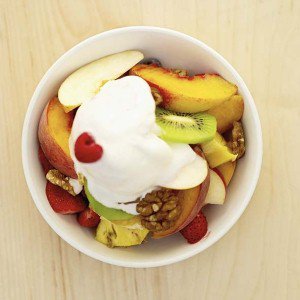The combined activities of eating for two and combating morning sickness make mealtime tough for many women during a pregnancy. How are you supposed to get those extra calories in if you can't even stomach them? One way to sidestep nausea after eating is to separate your food into snacks rather than large meals, which could also help prevent heartburn. These smaller portions are more manageable for your stomach, and they give you the opportunity to indulge in plenty of different foods to satisfy your seemingly endless cravings. So what are the healthiest options for you and your baby? Try incorporating these 10 foods into your diet.
1. Figs. Whether dried or fresh, figs are a great source of the nutrients that your body and your growing baby's body need. Rich in fiber, calcium, potassium, phosphorus, iron and magnesium, they're practically prenatal vitamins in and of themselves! Aim to eat 1 cup each serving.
2. Nachos. Yes, nachos can be good for you if you make them at home with the right ingredients. Opt for baked tortilla chips, then sprinkle on some low-fat shredded cheese and pop them in the microwave. Top with a few spoonfuls of jarred salsa (or fresh, if you're feeling ambitious), which is usually low in calories and fat. You might even want to add a bit of fresh guacamole to get the heart-healthy benefits of avocados.
3. Low-fat Greek yogurt. With twice the protein of regular yogurt and a creamier consistency, Greek yogurt is a favorite of many people. It also has tons of calcium, which means strong bones for you and your little one. Try fruit flavors or add your own fresh ingredients to plain varieties.
4. Smoothies. When you make them at home instead of buying them at a fast food joint, these drinks can be packed with vitamins and nutrients. Mix plain low-fat yogurt, unsweetened fruit juice and fresh or frozen fruit in the blender for a simple recipe, or look up more healthy recipes online.
5. Cereal. If you're a breakfast person, why not indulge in a bowl of cereal whenever you're feeling hungry? Look for high-fiber varieties, then add some fresh berries and low-fat or fat-free milk.
6. Artichokes. These tasty veggies are super easy to prepare (just pop in a bowl with an inch or two of water, cover and put in the microwave for about five minutes) and taste great with a dip like hummus, low-fat mayo or salad dressing. Plus they have energizing iron and folate.
7. Pumpkin seeds. Craving something crunchy? Save those pumpkin seeds this fall and roast them – roasted seeds have more protein, minerals and fiber than raw seeds. Just toss with olive oil, spread over a baking sheet, season with the spices of your choice and bake at 300 degrees Fahrenheit until they're a bit browned.
8. Whole wheat English muffins. These baked goods are usually fortified with vitamins, iron, magnesium and zinc, and they're packed with fiber. Add a bit of honey and fruit on top, or add a slice of cheese for extra protein and calcium.
9. Popcorn. Believe it or not, popcorn is actually a whole grain! It's high in fiber and nutrients, including vitamin E, selenium and phytonutrients, which help protect human cells. Pop your own and shake on a bit of garlic salt for a flavor kick.
10. Eggs. No matter how you eat them, eggs are packed with more than 12 vitamins and minerals, as well as tons of protein. Hard-boiled is the most portable way to snack on them.
